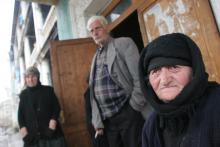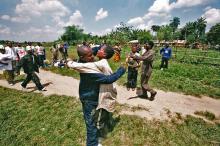Case prepared by Laura Di Gianfrancesco, Reine Pfister and Thilo Tesing, LL.M. students at Roma Tre University under the supervision of Giulio Bartolini (Professor) and Tommaso Natoli (Research assistant), Roma Tre University IHL Legal Clinic; with the contribution of Jemma Arman and Isabelle Gallino, LL.M. students at the Geneva Academy.
A. LEADERS OF ARMED GROUPS AGREE TO RELEASE CHILD SOLDIERS AT THE BANGUI FORUM
5 May 2015 – As part of an agreement facilitated by the United Nations Children’s Fund (UNICEF), up to 10,000 children currently associated with armed groups in the Central African Republic (CAR) will be released from roles such as combatants, sex slaves and cooks, a spokesperson for the agency told reporters in Geneva today.
Christophe Boulierac, briefing on behalf of UNICEF, said CAR was one of the worst places in the world for children, especially after the last two years of violence. The leaders of armed groups agreed not only to release between 6,000 and 10,000 children but also to stop future enrolment and to grant UNICEF immediate and restriction-free access to any zone under the groups’ control.
He explained that the agreement took place under the auspices of the National Reconciliation Forum trying to re-establish peace in the country. The gathering, known as the Bangui Forum, after the war-torn country’s capital, is bringing together leaders of armed groups as well as religious leaders, members of Government and Parliament for discussions on maintaining peace and is considered a crucial step in the reconciliation process and in preparing the ground for a constitutional referendum and parliamentary and presidential elections.
At the opening of the Forum, which is expected to run through 11 May, the Special Representative of the Secretary-General for the Central African Republic, Babacar Gaye, who also heads the Multidimensional Integrated Stabilization Mission in the country (MINUSCA), expressed the Secretary-General’s hope and confidence that parties would show the “will to make the Forum a success.”
In his address, Mr. Gaye advised parties to work in an atmosphere of forgiveness, and he called for dialogue and consensus-building in the Forum’s negotiations and an agreement that would see free, fair democratic and transparent elections tale place that are open to all, including refugees and displaced persons.
The commitment made by armed groups after preliminary discussions with the Government on 23 April to take part in the Forum fuelled hope in the international community, he said, emphasizing the need for disarmament and for formation of a professional and representative national army.
“It is time for the guns fall silent in this country,” Mr. Gaye said. “We, the international community, are and will remain with you on the road to peace.”
B. BANGUI AGREEMENT INTO PRACTICE: THE RELEASE OF 359 CHILDREN
[Source: Marie-Thérèse Keita Bocoum, Report of the Independent Expert on the situation of human rights in the Central African Republic, A/HRC/30/59, 24 July 2015, available at https://digitallibrary.un.org/record/801739]
70. The demobilization of child soldiers, which had already begun in 2014, saw significant progress in May 2015 following the Bangui Forum and the agreement signed by 10 armed groups on laying down their arms, renouncing armed struggle as a means of imposing political demands, and releasing the children among their ranks. In 2014, a total of 2,807 children were removed from armed groups in the Central African Republic, including 2,374 from anti-balaka groups and 460 from the former Séléka factions. On 14 May 2015, 357 children were released in Bambari by anti-balaka militia and former Séléka fighters. The United Nations Children’s Fund (UNICEF) and its partners have established family reunification programmes, psychological counselling and community reintegration programmes.
71. Save the Children recently published a study showing that nearly two thirds of school-age children suffer from post-traumatic stress disorder as a result of the violence they witnessed or experienced during the two years of conflict. The study reports that more than 60 per cent of children in the Central African Republic have witnessed or have been subjected to acts of extreme violence since March 2013.
72. This situation is cause for serious concern about the country’s future. There is an urgent need to invest in the strategy for lasting peace and reconciliation in order to enable these children to rebuild their lives in peace.
C. CEREMONIES TO RELEASE CHILDREN IN BATANGAFO
BATANGAFO, Central African Republic, August 28 2015 – An additional 163 children – including 5 girls - have been released by an armed group in the Central African Republic.
The children were released by the anti-Balaka militia during a ceremony Friday in the town of Batangafo.
Today’s handover, which was facilitated by UNICEF and the United Nations Multidimensional Integrated Stabilization Mission in the Central African Republic (MINUSCA), comes three months after 357 children were released following an agreement between the country’s 10 armed groups to release all children from their ranks.
“This release is a sign that the process of implementing the commitment made by the leaders of these groups, as a part of the peace and reconciliation process, is on track,” said Mohamed Malick Fall, UNICEF’s Representative, who attended the ceremonies. "We fully expect to see hundreds more children released before the end of this year.”
The children released received medical care and spoke to social workers. They were then taken to a transition center where they will be supported in either going back to school or enrolling in vocational training. UNICEF and partners will also begin the process of tracing and reunifying the children with their families.
“Today marks an important step forward towards the end of the recruitment and use of children by armed groups in the Central African Republic and of course a step towards concrete peace in the country,” said Diane Corner, Deputy Special Representative of the Secretary General, who was represented at the ceremony. “This ceremony is the result of long and arduous work done by different partners including UNICEF, MINUSCA, the government as well as armed groups, to whom I extend my appreciation. MINUSCA is resolved with all partners to ensure the protection of children and I herewith reaffirm its determination to multiply efforts to identify and separate children who are waiting to return to normal life.”
Smaller release ceremonies also took place in the capital Bangui last week, and earlier in August in Basse Kotto and Mobaye districts during which a total of 125 children were freed, bringing the number of children liberated since May to 645.
UNICEF estimates that between 6,000 and 10,000 children have been associated with armed factions in CAR since 2013. This includes children serving as combatants, as well as those working as cooks, messengers and in other roles.
The agreement to release all children was made at a reconciliation forum in Bangui this past May. It also commits the groups to ending additional recruitment of children and gives UNICEF and its partners immediate and unrestricted access to the areas under the groups’ control in order to identify and verify the number of affected children and to secure their release.
D. THE UN INDEPENDENT EXPERT ENCOURAGES TO INCREASE THE EFFORTS TOWARDS THE PROTECTION OF CHILDREN
72. The situation of Central African children remains worrying. They are victims of violence, including sexual violence, and recruitment by armed groups. They continue to suffer from malnutrition and poor access to health and education services. The lack of routine birth registration also poses long-term problems. […]
75. By December 2015, nearly 5,000 children had been demobilized and between January and April 2016 around 1,298 children were released from armed groups. International actors responsible for child protection have drawn attention to the numerous demobilization-related challenges that vary depending on the armed group into which the children were taken. They have also condemned the lack of care and reintegration programmes; the Independent Expert considers it important to strengthen these in the coming months. She also encourages the establishment of rehabilitation centres for children in conflict with the law.
Discussion
I. Classification of the Situation and Applicable Law
1. How would you classify the situation in CAR? What additional information would you require in order to make such a determination? Under which conditions would Additional Protocol II be applicable? (
GC I-IV, Art. 3;
P II, Art. 1)
II. Protection of children in armed conflicts
2. What special protections are children afforded in non-international armed conflicts? Are they different from the rules applicable in international armed conflicts? (
P II, Art.4(3) and
6(4);
CIHL, Rules 135-
137)
III. Elements Contributing to Respect for IHL
4. Why is it important to bring together members of armed groups and of the Government, as well as religious leaders, to discuss return to peace in the country? In your opinion, was the Bangui Forum an environment conducive to improving respect for IHL?
5. What is the advantage of having a non-state actor making an agreement such as the one at the Bangui Forum? Do you think it makes sense for such actors to reinforce their obligations through deals? Could this fall under the category of “special agreements” mentioned in Common Art. 3 of the Geneva Conventions? (
GC I-IV, Art. 3)
6. (Document A) Do you think that the interest of the international community, “fuelled [by] hope” with the commitment of armed groups, can increase respect of IHL by such groups?
7. (Document C) Why do you think the ceremonies of releasing children were made public? What message could such public ceremonies send to the local population? To the international community? To the released children?
8. What roles did international actors, such as MINUSCA and UNICEF, have in terms of awareness raising, training and dissemination of IHL? What role did they play in the implementation of the Bangui Agreement? What do you think of UNICEF’s reunification and reintegration programmes and psychological counselling?
9. (Document A) Why is the fact that children are exposed to violence “a cause for serious concern about the country’s future”? (Document D) Why is it so difficult to implement reintegration and rehabilitation programmes in post-conflict situations? What measures should be taken to improve the protection of children in times of conflict? Prior to the conflict? In the midst of the conflict?






